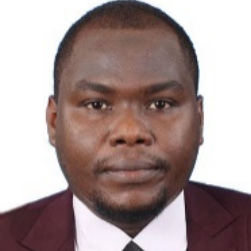International Journal of Computer Network and Information Security (IJCNIS)
IJCNIS Vol. 16, No. 3, 8 Jun. 2024
Cover page and Table of Contents: PDF (size: 1316KB)
Effect of Line-of-sight Channels on DC-biased Optical Filter Bank Multicarrier Visible Light Communication with Multiple LED Arrays
PDF (1316KB), PP.16-25
Views: 0 Downloads: 0
Author(s)
Index Terms
OWC, VLC, DCO-FBMC, Propagation Delay, Bit RateBER
Abstract
This paper investigates the impact of propagation delay and channel loss due to the use of multiple LED arrays in visible light communication (VLC) systems based on filter bank multicarrier (FBMC) modulation. FBMC offers greater spectral efficiency, and asynchronous transmission and is a promising alternative scheme to orthogonal frequency division modulation (OFDM). The proposed FBMC model is based on 4-quadrature amplitude modulation (QAM) and 16-QAM formats and uses 100 symbols and 600 input bits per symbol. In this paper, the VLC-FBMC system is designed based on the line-of-sight (LOS) model under the additive white Gaussian noise (AWGN) channel. Comparison analyses between different bit rates in terms of bit error rate (BER), best sampling point, and signal-to-noise ratio (SNR) requirement have been carried out to show the delay and loss effect on communication quality and system performance. The results demonstrate that the proposed FBMC model achieves a bit rate of up to 29.296 Mbit/s with a low BER of 10-3 and less SNR penalty in high QAM formats, demonstrating its potential as a viable alternative to OFDM for future VLC systems.
Cite This Paper
Mohammed Ali Asban, Rahmat Talib, Mohammad Faiz Abdullah, Mohammed S. M. Gismalla, "Effect of Line-of-sight Channels on DC-biased Optical Filter Bank Multicarrier Visible Light Communication with Multiple LED Arrays", International Journal of Computer Network and Information Security(IJCNIS), Vol.16, No.3, pp.16-25, 2024. DOI:10.5815/ijcnis.2024.03.02
Reference
[1]M. Hosney, H. A. Selmy, A. Srivastava, and K. M. Elsayed, "Interference mitigation using angular diversity receiver with efficient channel estimation in MIMO VLC," IEEE Access, vol. 8, pp. 54060-54073, 2020. doi: 10.1109/ACCESS.2020.2981137.
[2]G. A. Mapunda, R. Ramogomana, L. Marata, B. Basutli, A. S. Khan, and J. M. Chuma, "Indoor Visible Light Communication: A Tutorial and Survey," Wireless Communications and Mobile Computing, vol. 2020, p. 8881305, 2020/12/11 2020, doi: 10.1155/2020/8881305.
[3]T.-C. Yu, W.-T. Huang, W.-B. Lee, C.-W. Chow, S.-W. Chang, and H.-C. Kuo, "Visible light communication system technology review: Devices, architectures, and applications," Crystals, vol. 11, no. 9, p. 1098, 2021. doi: 10.3390/cryst11091098
[4]N. Chi, Y. Zhou, Y. Wei, and F. Hu, "Visible light communication in 6G: Advances, challenges, and prospects," IEEE Vehicular Technology Magazine, vol. 15, no. 4, pp. 93-102, 2020. doi: 10.1109/MVT.2020.3017153
[5]L. E. M. Matheus, A. B. Vieira, L. F. Vieira, M. A. Vieira, and O. Gnawali, "Visible light communication: concepts, applications and challenges," IEEE Communications Surveys & Tutorials, vol. 21, no. 4, pp. 3204-3237, 2019. doi: 10.1109/COMST.2019.2913348
[6]D. W. Dawoud, F. Héliot, M. A. Imran, and R. Tafazolli, "A novel unipolar transmission scheme for visible light communication," IEEE Transactions on Communications, vol. 68, no. 4, pp. 2426-2437, 2019. DOI: 10.1109/TCOMM.2019.2963377
[7]Z. Ghassemlooy, L. N. Alves, S. Zvanovec, and M.-A. Khalighi, Visible light communications: theory and applications. CRC press, 2017. doi: 10.1201/9781315367330
[8]N. E. Mahfouz, H. A. Fayed, A. Abd El Aziz, and M. H. Aly, "Improved light uniformity and SNR employing new LED distribution pattern for indoor applications in VLC system," Optical and Quantum Electronics, vol. 50, pp. 1-18, 2018. doi: 10.1007/s11082-018-1618-6
[9]T. Ganjian, G. Baghersalimi, and Z. Ghassemlooy, "Performance evaluation of the received power based on the transmitter position in a visible light communications system," in 2017 Iranian Conference on Electrical Engineering (ICEE), 2017: IEEE, pp. 1763-1768. doi: 10.1109/IranianCEE.2017.7985336
[10]Y. S. Hussein, M. Y. Alias, and A. A. Abdulkafi, "On performance analysis of LS and MMSE for channel estimation in VLC systems," in 2016 IEEE 12th International Colloquium on Signal Processing & Its Applications (CSPA), 2016: IEEE, pp. 204-209. doi: 10.1109/CSPA.2016.7515832.
[11]B. Aydin and Ç. Duman, "Comparison of OOK-RZ and 4-PPM performances in Li-Fi systems using LED arrays," Optics & Laser Technology, vol. 153, p. 108247, 2022. doi: 10.1016/j.optlastec.2022.108247
[12]S. Kumar and P. Singh, "Spectral efficient asymmetrically clipped hybrid FBMC for visible light communication," International Journal of Optics, vol. 2021, pp. 1-8, 2021. doi: 10.1155/2021/8897928
[13]A. E. Ibhaze, P. E. Orukpe, and F. O. Edeko, "High capacity data rate system: Review of visible light communications technology," Journal of Electronic Science and Technology, vol. 18, no. 3, p. 100055, 2020. doi: 10.1016/j.jnlest.2020.100055
[14]K. K. Vaigandla and J. Benita, "Study and analysis of multi carrier modulation techniques–FBMC and OFDM," Materials Today: Proceedings, vol. 58, pp. 52-56, 2022. doi: 10.1016/j.matpr.2021.12.584.
[15]S. Alshami, "Performance Analysis of OFDMA, UFMC, and FBMC for Optical Wireless Communication," in 2021 1st International Conference on Emerging Smart Technologies and Applications (eSmarTA), 2021: IEEE, pp. 1-4. DOI: 10.1109/eSmarTA52612.2021.9515739
[16]P. Kansal and A. K. Shankhwar, "FBMC vs OFDM waveform contenders for 5G wireless communication system," Wireless Engineering and Technology, vol. 8, no. 4, pp. 59-70, 2017. doi: 10.4236/wet.2017.84005.
[17]D. Mattera, M. Tanda, and M. Bellanger, "Comparing the performance of OFDM and FBMC multicarrier systems in doubly-dispersive wireless channels," Signal Processing, vol. 179, p. 107818, 2021. doi: 10.1016/j.sigpro.2020.107818
[18]S. Kumar and P. Singh, "Filter bank multicarrier modulation schemes for visible light communication," Wireless Personal Communications, vol. 113, no. 4, pp. 2709-2722, 2020. doi: 10.1007/s11277-020-07347-6.
[19]S. S. Oyewobi, K. Djouani, and A. M. Kurien, "Visible light communications for internet of things: Prospects and approaches, challenges, solutions and future directions," Technologies, vol. 10, no. 1, p. 28, 2022. doi: 10.3390/technologies10010028
[20]H. H. H. Mahmoud, A. A. Amer, and T. Ismail, "6G: A comprehensive survey on technologies, applications, challenges, and research problems," Transactions on Emerging Telecommunications Technologies, vol. 32, no. 4, p. e4233, 2021. doi: 10.1002/ett.4233
[21]Ali J. Ramadhan, "Overview and Comparison of Candidate 5G Waveforms: FBMC, UFMC and F-OFDM", International Journal of Computer Network and Information Security, Vol.14, No.2, pp.27-38, 2022.
[22]M. S. Bahaaelden, B. Ortega, R. Perez-Jimenez, and M. Renfors, "Efficiency analysis of a truncated flip-FBMC in burst optical transmission," IEEE Access, vol. 9, pp. 100558-100569, 2021. DOI: 10.1109/ACCESS.2021.3096660
[23]R. Chen, K.-H. Park, C. Shen, T. K. Ng, B. S. Ooi, and M.-S. Alouini, "Visible light communication using DC-biased optical filter bank multi-carrier modulation," in 2018 global LIFI congress (GLC), 2018: IEEE, pp. 1-6. doi:10.23919/GLC.2018.8319094
[24]J. Dang, Z. Zhang, L. Wu, and L. Guo, "DC and non-DC biased optical filter bank multicarrier communication for IM/DD channel," in 2016 IEEE international conference on communications workshops (ICC), 2016: IEEE, pp. 423-429. doi: 10.1109/ICCW.2016.7503824.
[25]R. Nissel, M. Rupp, and R. Marsalek, "FBMC-OQAM in doubly-selective channels: A new perspective on MMSE equalization," in 2017 IEEE 18th International Workshop on Signal Processing Advances in Wireless Communications (SPAWC), 2017: IEEE, pp. 1-5. doi: 10.1109/SPAWC.2017.8227806.
[26]A. A. Qasim, M. Abdullah, and R. Talib, "Adaptive DCO-FBMC in Visible Light Communication," in IOP Conference Series: Materials Science and Engineering, 2020, vol. 767, no. 1: IOP Publishing, p. 012018. DOI: 10.1088/1757-899X/767/1/012018
[27]L. Wu, Z. Zhang, J. Dang, and H. Liu, "Adaptive modulation schemes for visible light communications," Journal of Lightwave Technology, vol. 33, no. 1, pp. 117-125, 2014. doi: 10.1109/JLT.2014.2374171.
[28]A. Al-Kinani, C.-X. Wang, L. Zhou, and W. Zhang, "Optical wireless communication channel measurements and models," IEEE Communications Surveys & Tutorials, vol. 20, no. 3, pp. 1939-1962, 2018. DOI: 10.1109/COMST.2018.2838096
[29]M. Obeed, A. M. Salhab, M.-S. Alouini, and S. A. Zummo, "On optimizing VLC networks for downlink multi-user transmission: A survey," IEEE Communications Surveys & Tutorials, vol. 21, no. 3, pp. 2947-2976, 2019. DOI: 10.1109/COMST.2019.2906225
[30]Z. Ghassemlooy, W. Popoola, and S. Rajbhandari, Optical wireless communications: system and channel modelling with Matlab®. CRC press, 2019. doi.org/10.1201/9781315151724



